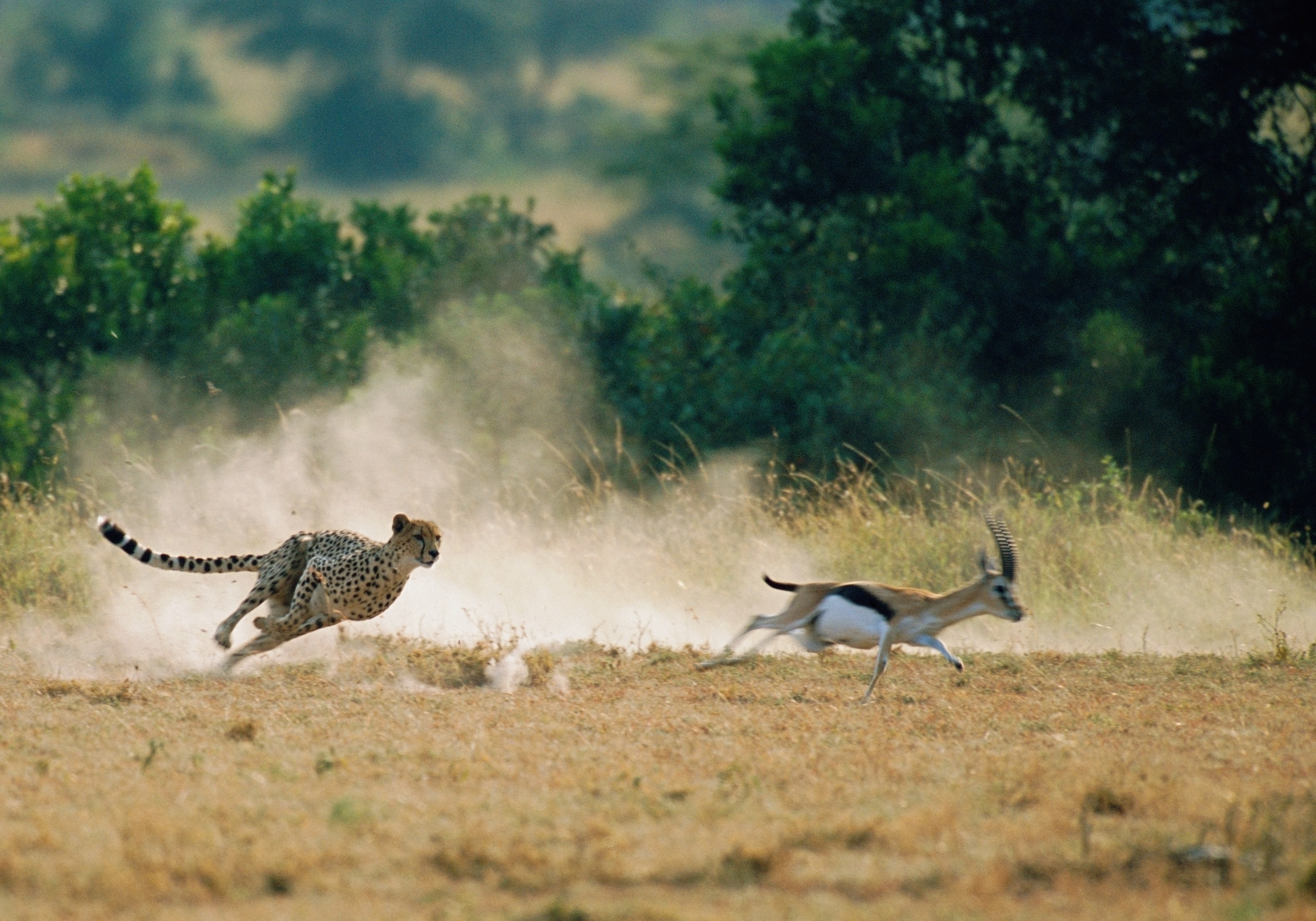Cheetahs, often hailed as the Formula One cars of the natural world, rightfully earn their reputation as the planet’s fastest land mammal. These magnificent big cats are perfectly sculpted for incredible bursts of speed, designed by evolution for high-speed chases across their savannah and grassland homes. But just how fast can a cheetah run? The answer is astonishing, and the science behind their speed is even more fascinating.
This article delves into the remarkable speed capabilities of cheetahs, exploring the biological adaptations that make them nature’s speed champions. We’ll uncover not only their top speed but also the incredible acceleration that leaves other animals in the dust. Beyond speed, we’ll also touch upon other key aspects of cheetah life, from their habitat and diet to how they differ from other big cats like leopards, providing a comprehensive look at these incredible creatures.
Cheetah Speed: Breaking Down the Numbers
When we talk about cheetah speed, we’re not just talking about a brisk jog. Cheetahs can reach speeds of up to 120 kilometers per hour (75 miles per hour). To put that into perspective, that’s faster than most speed limits on highways! This makes them not only the fastest land animal but also one of the fastest animals on Earth, period.
But top speed is only part of the story. What truly sets cheetahs apart is their acceleration. Imagine going from 0 to 60 mph in just a few seconds – that’s cheetah-level acceleration! Scientific studies have revealed that cheetahs can increase their speed by an astounding 10 kilometers per hour in a single stride. This rapid acceleration is crucial for hunting prey that are agile and quick themselves.
A cheetah displaying its incredible speed while chasing a Thomson’s gazelle across the African savanna.
The Biological Secrets Behind Cheetah Speed
Cheetahs aren’t just naturally fast; they possess a suite of physical adaptations that work in perfect harmony to enable their incredible speed. Think of them as meticulously engineered speed machines, honed over millennia for one purpose: to run faster than anything else on land. Here are five key adaptations that contribute to their speed prowess:
1. The Role of the Long Tail in Cheetah Agility
A cheetah’s tail isn’t just for show. Measuring an impressive 60 to 90 centimeters, it accounts for almost half of their head and body length. This long, muscular tail acts as a crucial counterbalance, much like a rudder on a boat or the wings of an airplane. At high speeds, when making sharp turns to pursue agile prey like gazelles, the tail allows the cheetah to maintain balance and maneuverability, preventing them from losing control.
2. The Flexible Spine: Extending Stride Length for Maximum Speed
The cheetah’s spine is a marvel of natural engineering. Exceptionally long and flexible, it allows for a greater range of motion during running. As the cheetah runs, its spine dramatically flexes and straightens, significantly increasing the length of each stride. This extended stride length is a key factor in achieving and maintaining top speeds. Imagine the spine acting like a spring, coiling and releasing to propel the cheetah forward with each powerful bound.
3. Large Lungs: Fueling the Cheetah’s Need for Speed
Running at top speed is an incredibly energy-intensive activity. To power their muscles during these sprints, cheetahs require a massive amount of oxygen. To meet this demand, cheetahs have evolved enlarged respiratory tracts and exceptionally large lungs. During a high-speed chase, a cheetah’s breathing rate can skyrocket from a resting rate of 60 breaths per minute to an astonishing 150 breaths per minute. This rapid breathing ensures a constant and plentiful supply of oxygen to their hard-working muscles.
4. Specialized Feet and Claws for Superior Grip
Traction is paramount when running at high speeds. Cheetahs have several adaptations in their feet and claws that enhance grip and prevent slippage. Unlike many other cats, cheetahs have reduced webbing between their toes, allowing their toes to splay out widely for increased ground contact. Furthermore, their claws are semi-retractable, meaning they remain partially extended even when retracted. This is unlike other cats who fully retract their claws. Cheetah claws act like permanent running spikes, digging into the ground to provide exceptional grip and prevent them from losing traction, especially on uneven terrain.
5. Elongated Legs: Built for Speed, Not Climbing
Compared to other big cats like lions or leopards, cheetahs have noticeably longer legs. This elongation extends to all leg bones, contributing significantly to their stride length and speed. Interestingly, the tibia and fibula bones in their lower legs are also fused. While this fusion provides greater stability at high speeds, it comes at a cost. This adaptation makes cheetahs less adept at climbing trees compared to other cats, highlighting how their bodies are optimized for speed above all else.
A close-up of a female cheetah showcasing her teeth, highlighting features that, while not directly related to speed, are crucial for hunting and survival.
Cheetah Habitat and the Threats They Face
Historically, cheetahs roamed across vast stretches of Africa and the Middle East. However, over the past century, their population has tragically declined by an estimated 90%. Today, they are primarily found in the dry savannahs and grasslands of Africa. Southern Africa holds the largest cheetah population, while a critically endangered population of Asiatic cheetahs, numbering only around 50, clings to survival in Iran.
Habitat loss and fragmentation, largely due to human encroachment and agricultural expansion, pose a significant threat to cheetah populations. Additionally, a reduction in their prey base, often linked to human activities and competition with livestock, further jeopardizes their survival. The International Union for Conservation of Nature (IUCN) currently classifies cheetahs as “Vulnerable,” highlighting their precarious status in the wild. Conservation efforts are crucial to protect these magnificent animals and their remaining habitats.
What Do Cheetahs Eat? The Diet of a Speed Hunter
Cheetahs are carnivores, and their diet is heavily influenced by their incredible speed. They are opportunistic hunters, preying on a range of animals depending on availability. While they will hunt smaller animals like rabbits and game birds, their speed truly comes into play when pursuing larger prey. Gazelles, impalas, puku, and warthogs are all common targets for cheetahs.
When hunting in groups, cheetahs can even take down larger ungulates (hoofed mammals). Their hunting strategy relies heavily on their speed and acceleration to chase down and overwhelm their prey. Cheetahs possess specialized physical features for dispatching prey, including a high forehead and modified jaws that provide a powerful, vice-like grip for throttling their victims. Unlike other big cats who sever the spinal cord, cheetahs have short, sharp canine teeth designed for efficiently consuming meat.
Cheetahs vs. Leopards: Spotting the Difference
Cheetahs and leopards are often confused due to their spotted coats, but they are distinct species belonging to different genera. Cheetahs belong to the genus Acinonyx, with Acinonyx jubatus being the only living species. Leopards, on the other hand, belong to the genus Panthera, which also includes lions, tigers, and jaguars.
Geographically, cheetahs are primarily found in Africa and a small population in Iran, while leopards have a wider distribution across Africa, Central Asia, India, and China. Visually, the most striking difference lies in their spot patterns. Leopards have “rosettes,” which are rose-like markings, while cheetahs have solid, round spots. Leopards are also generally more muscular and stockier than the slender, streamlined cheetah. Another key distinguishing feature is the cheetah’s distinctive black “tear stripes” that run from the corner of their eyes down their muzzle, which leopards lack.
A mother cheetah with her cubs in the Maasai Mara, Kenya. Notice the characteristic round spots and black tear stripes, key identifiers for cheetahs.
A leopard in Sri Lanka, displaying the rosette-shaped markings that differentiate them from cheetahs’ solid spots.
Baby Cheetahs: Cubs and Their Spots
Baby cheetahs are called cubs. Female cheetahs typically give birth to litters of two to eight cubs. These cubs are dependent on their mothers for survival and will remain with them until they are around 16 to 24 months old. The average lifespan of a cheetah in the wild is about 7 years.
Interestingly, cheetah cubs are born with spots, just like adult cheetahs. This spot pattern is unique to each individual cheetah, much like human fingerprints, and remains consistent throughout their lives. Newborn cheetah cubs have a distinctive appearance, being quite dark in color and sporting a mantle of silver-grey fur along their backs. This fluffy mantle provides camouflage, helping them blend into tall grass and offering protection from predators during their vulnerable early months. This mantle is typically lost by the time they are around three months old.
A cheetah family in their natural habitat. Baby cheetahs, or cubs, are born with spots and a distinctive mantle of fur for camouflage.
The Genetic Bottleneck: Inbreeding Among Cheetahs
Cheetahs faced a near-extinction event approximately 10,000 years ago, resulting in a severe genetic bottleneck. This bottleneck drastically reduced their genetic diversity, meaning that today’s cheetah population is descended from a very small number of ancestors. This lack of genetic diversity has led to inbreeding within the species.
Low genetic diversity can be a significant concern for a species’ long-term survival. It theoretically reduces their ability to adapt to changing environmental conditions and makes them more vulnerable to diseases. Conservation efforts are crucial not only to protect cheetah habitats and populations but also to address the challenges posed by their limited genetic diversity.
Conclusion: The Cheetah’s Reign as Speed Champion
Cheetahs are truly extraordinary animals, perfectly adapted for speed and agility. Their ability to reach speeds of 75 mph and accelerate faster than many sports cars is a testament to the power of evolution. From their long tails and flexible spines to their specialized feet and lungs, every aspect of their anatomy contributes to their incredible speed.
However, these magnificent creatures face numerous threats, including habitat loss, prey depletion, and low genetic diversity. Understanding how fast can a cheetah run is just the beginning of appreciating these incredible animals. Continued conservation efforts are essential to ensure that cheetahs continue to grace our planet and inspire awe with their speed and beauty for generations to come.


